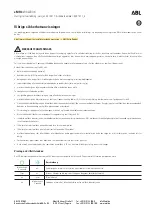
There is a gender difference, too. Women generally
have a lower relative percentage of body water
than men. Since alcohol is carried in body water, this
means that a woman generally will reach a higher BAC
level than a man of her same body weight will when
each has the same number of drinks.
The law in an increasing number of U.S. states, and
throughout Canada, sets the legal limit at 0.08 percent.
In some other countries, the limit is even lower. For
example, it is 0.05 percent in both France and Germany.
The BAC limit for all commercial drivers in the United
States is 0.04 percent.
The BAC will be over 0.10 percent after three to six
drinks (in one hour). Of course, as we have seen,
it depends on how much alcohol is in the drinks, and
how quickly the person drinks them.
But the ability to drive is affected well below a BAC of
0.10 percent. Research shows that the driving skills
of many people are impaired at a BAC approaching
0.05 percent, and that the effects are worse at night. All
drivers are impaired at BAC levels above 0.05 percent.
Statistics show that the chance of being in a collision
increases sharply for drivers who have a BAC of
0.05 percent or above. A driver with a BAC level of
0.06 percent has doubled his or her chance of having a
collision. At a BAC level of 0.10 percent, the chance
of this driver having a collision is 12 times greater; at a
level of 0.15 percent, the chance is 25 times greater!
The body takes about an hour to rid itself of the alcohol
in one drink. No amount of coffee or number of cold
showers will speed that up. “I will be careful” is not the
right answer. What if there is an emergency, a need
to take sudden action, as when a child darts into
the street? A person with even a moderate BAC might
not be able to react quickly enough to avoid the
collision.
There is something else about drinking and driving that
many people do not know. Medical research shows
that alcohol in a person’s system can make crash
injuries worse, especially injuries to the brain, spinal
cord or heart. This means that when anyone who has
been drinking — driver or passenger — is in a crash,
that person’s chance of being killed or permanently
disabled is higher than if the person had not been
drinking.
4-4
Summary of Contents for Silverado 2003
Page 5: ...These are some examples of vehicle symbols you may find on your vehicle v ...
Page 18: ...Put someone on it Get it up to speed Then stop the vehicle The rider doesn t stop 1 12 ...
Page 78: ...United States without Passenger Sensing System Canada with Passenger Sensing System 1 72 ...
Page 156: ... NOTES 2 68 ...
Page 159: ... NOTES 3 3 ...
Page 160: ...Instrument Panel Overview 3 4 ...
Page 194: ...Canada with Passenger Sensing System Canada without Passenger Sensing System 3 38 ...
Page 282: ... NOTES 3 126 ...
Page 380: ... NOTES 4 98 ...
Page 394: ...When you lift up the hood on the VORTEC 8100 V8 engine you will see the following 5 14 ...
Page 461: ...Removing the Spare Tire and Tools Regular Cab and Crew Cab Extended Cab 5 81 ...
Page 494: ...5 114 ...
Page 525: ...Maintenance Record cont d Date Odometer Reading Serviced By Maintenance Record 6 23 ...
Page 526: ...Maintenance Record cont d Date Odometer Reading Serviced By Maintenance Record 6 24 ...
Page 556: ... NOTES 20 ...
















































